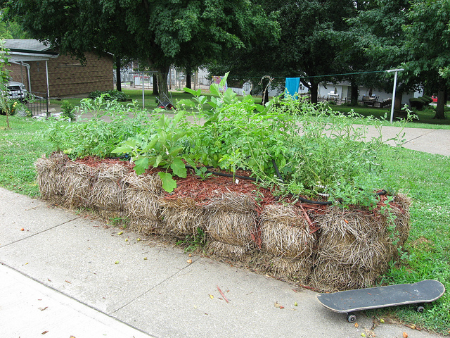Strawbale Gardening

Growing vegetables in straw bales has grown in popularity across the United States over the last few years. There are many benefits to growing vegetables in straw and several reasons why people have tried this unique gardening method. While straw bale gardening might not work for everyone, and let’s be honest, no gardening method will work for everyone, I think it is something everyone should try at least once.
There are many reasons gardeners try straw bale gardening. One of the most common reasons I’ve heard relates to the poor condition of the soil they have to garden in. The straw bale sits on top of the soil, so you can avoid planting in soil contaminated with disease or chemicals. If you have hefty clay soil or very rocky soil due to where you live, gardening on top of the ground might work for you. Another reason I commonly hear is that the gardener has mobility issues, and the straw bales are a cheaper alternative to purchasing containers or raised beds. Unlike raised beds, straw bales do not have to be in the same spot yearly. You are stuck in that one spot for a year as the bales get heavy once watered in, but the following year, you start over with new bales in a different location. One of the most significant benefits of straw bales is the compost they produce during the growing season, which can be incorporated into your garden spot to improve poor soils.
Straw bale gardening is simple. You place straw bales and ensure the cut ends face up in a location with at least 6 to 8 hours of sunlight. Straw, not hay bales, work best as they tend to have fewer weeds or seeds that will grow when you water them. Once the bales have been placed where you want them, it’s time to “condition” them over 12 days. Essentially, you are starting the composting process using water and fertilizer. Conditioning follows the process below:
- Day 1-3 Water the bale to saturation
- Day 4-6 Sprinkle 1/2 c. Urea (46 - 0 - 0) on the top of each bale and water the fertilizer, careful not to wash the fertilizer away. The fertilizer should start to work its way into the bale from the stream of water. It may not completely disappear, but it should not remain entirely on the top of the bale.
- Day 7-9 Reduce the fertilizer to 1/4 c. Urea and water the fertilizer in
- Day 10-11 Stop fertilizing, keep the bale moist.
As decomposition starts, the bale will heat up, and the microbes will break down the straw. This is a good sign. Check the top of the bale on day 11, and as long as it is cool to the touch, you are ready to start planting. You can grow almost any vegetable in the bales, except for corn (only because they get top-heavy and fall over with the height of the corn). If planting plants directly into the bales, make a hole with a trowel or knife and place a small amount of potting soil or compost in the hole where the transplants can be planted. If you use seeds, spread a layer of compost or potting soil across the top of the bale and plant like you would in the ground.
Water and fertilizer will be essential after the bales are conditioned and planted. Watering will be key, especially during the hot days of summer. Many people use a soaker hose to keep the bales damp. Watering by hand is also a great option, as you can scout for diseases or other issues. You will have to add a complete fertilizer with Nitrogen, phosphorus, and Potassium to keep the plants growing, as there are not enough nutrients in the bales themselves. You might have to fertilize once a week during active growth or vegetable production periods, depending on the fertilizer used. Once the season is over, the bales can be broken apart on a compost pile or a future garden spot.
Straw bale gardening is an enjoyable alternative to growing the garden in the ground, and it can be a less expensive way to garden in a raised bed fashion. It’s something to try in your yard. Be aware that during hot and dry periods, you may have to water the bales twice a day to keep the moisture levels high enough.

Have questions? Contact our office where our Horticulture Extension Agent will assist you with questions.
Phone: (316) 321-9660
Email: callae@ksu.edu